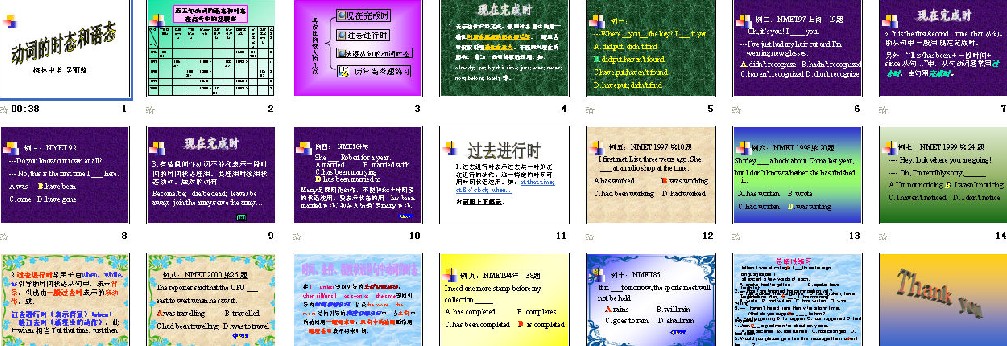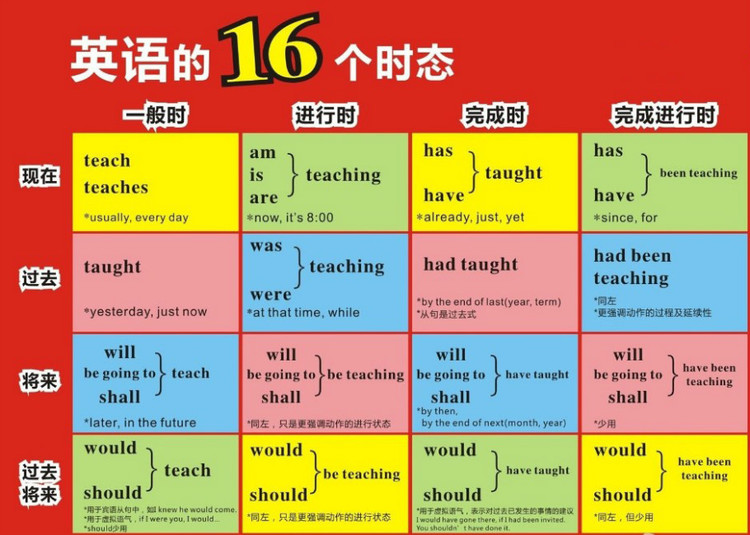時態(tense)是一種動詞形式,不同的時態用以表示不同的時間與方式。它是表示行為、動作、狀態在各種時間條件下的動詞形式,在英語中有16種時態。
基本介紹
- 中文名:時態
- 外文名:tense
- 形式:動詞形式
- 領域:英語語法
名詞解釋
 英語時態
英語時態種類
現在時
一般現在時
He is always ready to help others.
Action speaks louder than words.
表示經常性動作或狀態時,常與often,always,usually,sometimes,every day等時間狀語連用。如:
The shop opens at nine every day. 這家商店每天九點開門。
It seldom snows here. 這兒很少下雪。
(2)表示客觀存在或普遍真理
Light travels are faster than sound. 光速比聲速快。
Food easily goes bad in hot weather. 天氣熱時食物容易壞。(3)表示主語的特徵或狀態
The picture looks very beautiful. 這幅畫看起來很美。
Air contains oxygen and nitrogen. 空氣含有氧和氮。
(4在時間和條件狀語從句中表示將來的動作或狀態
I'll tell her about it as soon as I see her.
When does the train arrive? 火車幾點到?
(5) 用於圖片說明或劇本中的動作提示和背景說明
INSIDE THE SHELTER: Stockton slowly turns to face his wife. The angry screaming cries of the people ring in their ears even as they depart.
防空洞中:斯道克頓慢慢轉過身,面對他的妻子。那群人正在離去,而他們憤怒的尖叫聲卻還迴響在他們的耳邊。
(6) 電視節目直播解說
It's Carter to serve- he needs just one more point. He serves. And Smith misses. What a great serve!So the championshipgoes to 19-year-old Harry Carter.
該卡特發球了,他只需再得一分就贏了。他發球了,史密斯接球失誤。多漂亮的發球!冠軍屬於了19歲的哈利-卡特。
現在進行時
(1)進行時表示說話時或現階段正在進行的動作
表示現階段正在進行的動作,通常用表示現階段的時間狀語,如:today,this week,this month,this year,this term,now等。如:
He is writing a novel now. 他目前正在寫一部小說。
(2)進行時表示經常性的動作
進行時在表示經常性、重複性或習慣性的動作時必須與only,merely,simply,really,fast,rapidly,steadily,forever,all the time,always,constantly,continually,repeatedly等頻度副詞連用。如:
She is always complaining. 她總是在抱怨。
(3)進行時表示按計畫或已安排好要做的事
這一用法只適用於某些動詞,如:go,come,leave,start,arrive,return,spend,sail,meet,fly等。如:
The guest is leaving by train tonight. 客人今晚坐火車走。
(4) 補充說明
[1] 在不少情況下,表示正在進行的動作的漢語句子,並沒有“正在”這樣的字眼,但在譯為英語時必須用進行時態。如:
It's rainingheavily. 下大雨了。
How is everything going? 事情進展如何?
[2] 有些動詞通常不能用進行時。不能用進行時的動詞有:
表示感覺或感情的詞,如:hear,see,smell,taste,feel,seem,notice,hate,love,like,want,wish,refuse,prefer,forgive等。
表示存在或所屬的詞,如:exist,stay,remain,obtain,have,own,form,contain等。
表示認識或理解的詞,如:understand,know,remember,forget,believe,think,doubt等。
現在完成時
完成進行時
(1)完成進行時表示從過去一直持續到的動作或剛剛結束的動作
I've been writing letters all this morning.我寫了一上午信。(動作不再繼續)
O'Neil is ill. He' s been lying in the bed for three weeks.奧尼爾在病中,已臥床3個星期了。(動作會繼續下去)
(2)完成進行時表示從過去到現在的重複性動作
完成進行時的這種用法所表示的並不是一直在進行的動作,而是斷斷續續地反覆發生的動作。如:
What have you been doing all this time?你一直都在乾什麼來著?(動作可能繼續下去)
That reporter has been contributing articles to this magazine all these years.這些年那個記者一直為這家雜誌撰稿。(斷斷續續地反覆發生的動作)
過去時
一般過去時
(1)一般過去時表示過去的動作或狀態
[1]一般過去時通常與表示過去的時間狀語連用。
與一般過去時連用的時間狀語有:yesterday,last night(week,year,month,Sunday),then,at that time,at that moment,just now,a few days(weeks,months,years) ago等。例句:
Lucy turned off all the lights before she went out.
出門前露茜關了所有的燈。
[2]一般過去時也可以與today,this week(month,year)等時間狀語連用,但這些時間狀語應指過去。如:
Did you see him today? 你今天見他了嗎?(today指今天已過去的某一時刻)
[3]一般過去時還可以和for或since引導的時間狀語連用。如:
I stayed there for two months. 我在那裡呆了兩個月。
Nothing happened since then. 打那以後什麼事都沒有發生。
(2) 有時一般過去時的時間狀語或是在上下文、或是暗含於句中
Who was that? 那人是誰?
I saw Ker in town. 我在城裡看見了克爾。
(3)一般過去時在時間和條件狀語從句中表示過去將來的動作或狀態。
Hans said he would let us know if he got any news.
漢斯說要是得到訊息就告訴我們。
過去進行時
(1)過去進行時表示過去某時正在進行的動作
[1]過去進行時通常和時間狀語連用。如:
We were having dinner when they came.他們來的時候,我們正在吃飯。
[2]過去進行時表示過去某段時間內持續的動作。如:
Carlos was staying at home all last week.上周整整一周卡洛斯都在家呆著。
They were building a dam last spring. 去年春天他們一直在修一個水壩。
[3]過去進行時表示與過去某個動作同時發生的動作。如:
I was reading while she was writing. 我在讀書,她在寫字。
[4] 有時過去進行時用於主句,位於其後的when引導的從句表示意外發生的情況:
I was walking in the street when it began to rain.我正在街上走著,突然下起了雨。
(2)過去進行時表示過去將來的動作
過去進行時的這種用法多表示過去的打算,通常僅限於come,go,leave,depart,start等一些表示移動的動詞。如:
He didn't know whether she was coming. 他不知道她是否會來。
The delegation was departing three days later. 代表團打算三天后動身。
過去完成時
基本結構:主語+had+過去分詞(done)
①肯定句:主語+had+過去分詞+其他
②否定句:主語+had+not+過去分詞+其他
③一般疑問句:Had+主語+過去分詞+其他
④特殊疑問句:特殊疑問詞+一般疑問句
(1)過去完成時表示過去某時之前結束的動作或狀態
When he got there,the train had already left.他到了那兒時火車已經離開了。
Ina realized she had made a mistake.艾娜意識到她犯了個錯誤。
(2)過去完成時與when等從句連用
had+just / barely / hardly / scarcely+done...when...,no sooner...than... 是表示“剛……就……”或“不等……就……”的固定句型。如:
No sooner had we left the house than it began to rain.我們剛離開家就開始下雨了。
I had not gone much farther before I caught them up.我沒有走多遠就趕上他們了。
(3)過去完成時表示持續到過去某時之前的動作或狀態
We had finished the work by nine o'clock yesterday.昨晚九點前我們已完成了工作。
The company had completed the project by the end of 1999.到1999年底公司已完成了那個項目。
I had been looking for it for days before I found it.這個東西,我找了好多天才找著。
The telephone had been ringing for three minutes before it was answered.電話鈴響了三分鐘才有人接。
He was tired. He'd been working all day.他累了。他工作了一整天。
After he'd been lecturing for half an hour,Professor Brown had a drink of water.布朗教授講了半小時課之後,他喝了一點水。
將來時
一般將來時
(1) 基本用法
[1]一般將來時常用來表示將來時間的動作或狀況。如:
。
[2]一般將來時用於真實條件句和時間狀語從句的主句中表示將來的情況。如:
I'll tell you as soon as he comes. 他一來我就告訴你。
[3] 用於條件狀語從句表示願望或意願。如:
If you will wait for me,I shall come back soon.
如果你願意等我,我馬上就回來。
[4]一般將來時可用來表示一種傾向或習慣性動作。如:
The shop won't open until nine. 這家商店九點才會開門。
Children will be children. 孩子就是孩子。
(2) be going to +動詞原形
這一結構表示打算或準備好要做的事或有跡象表明要發生的天氣變化等情況。如:
What are you going to do during the summer holiday? 你暑假打算做什麼? The train is going to arrive. 火車就要到了。
(3)現在進行時(be +現在分詞)
有些動詞的現在進行時可以表示將要發生的動作,表示按計畫或安排即將發生的事。這類動詞有:go,come,leave,start,arrive,return,spend,sail,meet,fly等。如:
Annie is coming to supper this evening. 安妮今晚要來吃飯。
(4) be to +動詞原形
這一結構可表示約定、命令或按計畫要做的事。如:
When are they to come? 他們什麼時候來?
We are to meet at the school gate. 我們約好在校門口見。
(5) be about to +動詞原形
這一結構表示“即將做”或“馬上做”的意思。如:
He is about to leave. 他馬上就要動身。
The vacation is about to start. 假期即將開始。
將來進行時
將來完成時
過去將來時
轉換
方式
規則
- 一般過去時與現在完成時的轉換
在現在完成時中,延續性動詞能與表示一段時間的狀語連用,瞬間動詞卻不能。但是,可用別的表達方式:①瞬間動詞用於“一段時間 + ago”的一般過去時的句型中;②瞬間動詞可改成與之相對應的延續性動詞及短語,與一段時間連用;③瞬間動詞用於“It is + 一段時間 + since + 一般過去時”的句型,請看:
A. He joined the League two years ago.
B. He has been in the League for two years.
C. It is two years since he joined the League.
D. Two years has passed since he joined the League. - 一般現在時與現在進行時的轉換
在一般現在時中,at加上名詞表示“處於某種狀態”,如at work(在工作),at school(上學、上課)等。此短語可與進行時態轉換。請看:
Peter is at work,but Mike is at play.
Peter is working,but Mike is playing. - 現在進行時與一般將來時的轉換
在現在進行時態中go,come,leave,start,arrive等動詞常與表示將來的時間狀語連用表示將要發生的動作。如:I am coming,Mum! 意為“我就來,媽媽!”請看:
The train is leaving soon.
The train will leave soon.

 《英語教練》專業老師分享語法精髓
《英語教練》專業老師分享語法精髓